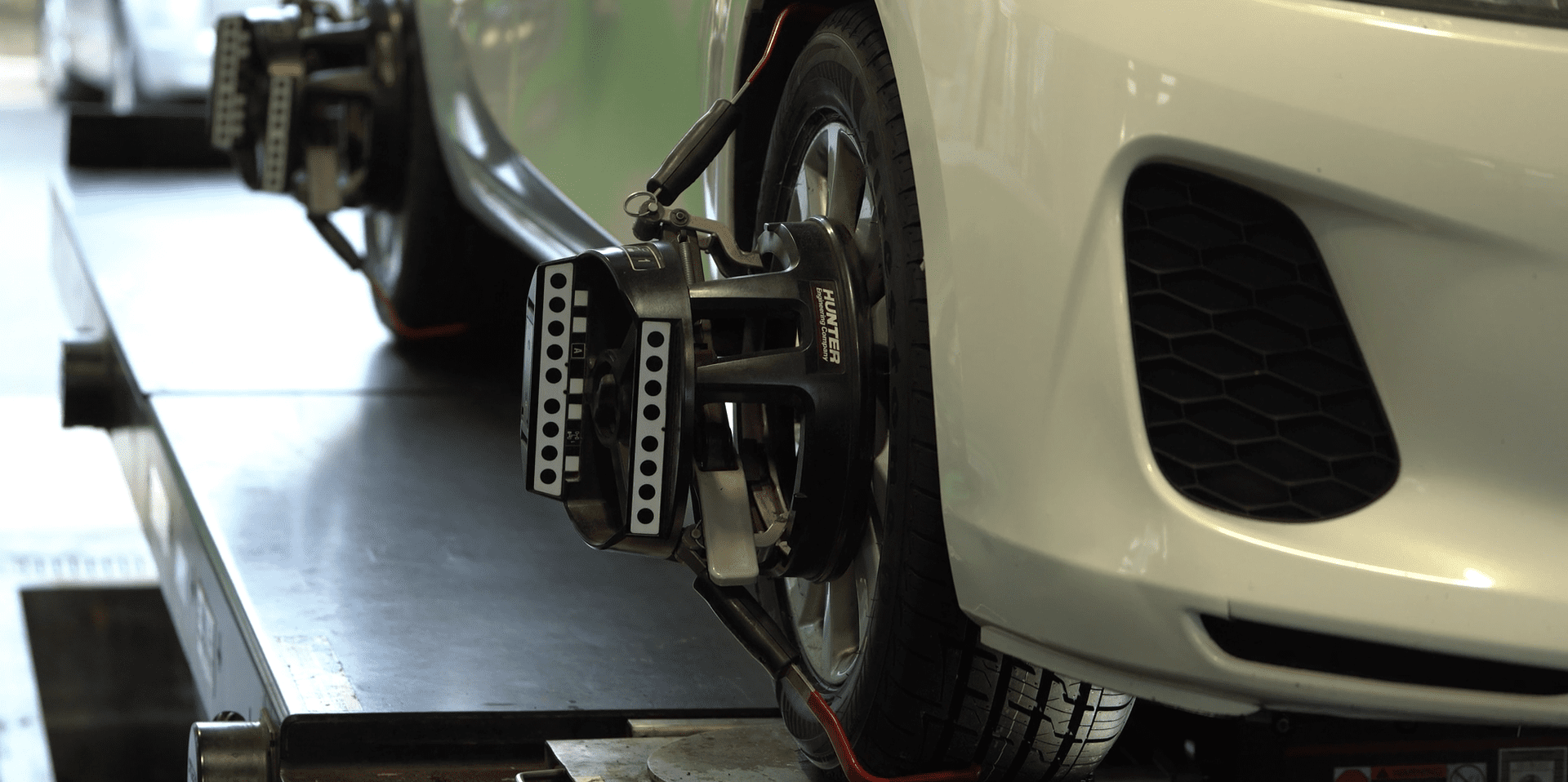Tire Balance vs. Alignment: Which One Do You Need?
The yoga studio isn’t the only place where you’ll hear the words balancing and alignment. You may also hear these words when you take your car in for service. But what do balancing and alignment mean off the yoga mat?
Having your tires balanced and wheels aligned is a critical part of regular car maintenance. Keep reading to learn more about these services, how to tell when you need them, where to get your regular vehicle maintenance, and more.
Tire Balance vs. Tire Alignment: Quick Look
| Service | Purpose | When to Get It | Benefits |
| Tire Balance | Corrects weight imbalances of your tires | • According to your manufacturer’s suggested maintenance schedule • If your floor, seat, or steering wheel vibrates • After changes to your tires (e.g., new tire install, rotation, or flat repair) | Smoother ride, helps promote even wear on your tires |
| Wheel Alignment | Adjusts tire angles for contact with the road | • According to your manufacturer’s suggested maintenance schedule • If your car is pulling to one side • If you experience a crooked steering wheel • If you notice uneven tire wear • After installing new tires | Smoother ride, helps tires wear evenly and maximize tire life |
What Is Tire Balancing?
Tire balancing (also known as wheel balancing) service corrects uneven weight distribution in the wheels by adding small metal weights. Tires are naturally imperfect and may not be exactly the same. Damage from potholes, curbs, or a rough road can further increase the differences. If you leave your car parked for extended periods without moving it, the tires might develop flat spots that cause imbalances.
The problem is that when your tires aren’t quite balanced, it can affect your driving experience and eventually impact other systems, like your suspension. That’s why having your tires balanced is essential.
How Does a Tire Balancing Work?
During a tire balance service, your tire and wheel assemblies are mounted onto a tire balancing machine. After a technician removes the old wheel weights, the machine spins the tire and wheel to measure the imbalance so that a technician can precisely install small metal weights to the wheel. Wheel balancing and alignment often happen during one service, but they shouldn’t be confused for the same thing.
What Are the Signs That Your Tires Need Balancing?
Uneven tire wear and vibration in your steering wheel, floorboard, or seat can signal it’s time for tire balancing. Imbalanced wheels can lead to vibration, excessive tire wear, damage to the suspension, and other problems. You may also want to have your tires balanced during a tire rotation, after a flat tire repair, or as part of your scheduled maintenance. New tires are always balanced before they are installed on the vehicle.
Interestingly, the part of your car that trembles can indicate whether the front or back wheels need balancing. If it’s in the steering wheel, it’s likely your front tires. If the vibration is in the seats, the imbalance is likely in the back wheels.
What Is Wheel Alignment?
Wheel alignment (also known as tire alignment) is an adjustment of a car’s steering and suspension. It’s not an adjustment of the tires or wheels themselves. Alignment keeps your car from veering to the right or left. It can also improve your vehicle’s handling and stop some unusual on-the-road vibrations.
What Are the Signs That Your Car Needs an Alignment?
Your vehicle might need an alignment if you notice any of the following:
- The car is pulling to one side of the road.
- The tire treads are wearing out prematurely or unevenly.
- The tires are squealing.
- The steering wheel tilts off-center when you’re driving.
- Your alignment can be thrown out of whack after a car accident, driving over a pothole, or running into a curb.
How Do Tire Balancing and Wheel Alignments Benefit Your Car?
The most significant benefit of balancing services is that they help prevent premature tire tread wear. Technicians agree that getting your tires balanced every 5,000 to 6,000 miles (or as your manufacturer recommends) can help extend their lifespan and improve their performance.
Wheel alignment benefits, on the other hand, include improved vehicle handling, fuel efficiency, and tire life. Firestone Complete Auto Care recommends checking your vehicle’s alignment every 6,000 miles or twice a year. Left untreated, alignment issues can shorten a tire’s life by thousands of miles and damage critical steering and suspension components.
How Do Balancing and Alignments Extend the Life of Your Tires?
When your tires are balanced, the weight of the tires and pressure of your vehicle is distributed evenly around the entire tire and wheel. This means that some spots on your tires won’t wear more than the rest and you can help maximize the full life of your tires.
When your wheels aren’t properly aligned, your tires can tilt or point in the wrong direction which can lead to excessive wear and tear. Having your wheels aligned also helps ensure that your tires wear more evenly, extending their life.
Firestone Complete Auto Care Can Help Maintain Tires & Wheels
Are you noticing symptoms of balancing and alignment issues in your car? Don’t let them disrupt your flow. Schedule an appointment at your nearest Firestone Complete Auto Care for a zen-like ride that’s both relaxing and reliable.
Wheel Alignment vs. Balance: What’s the Difference?

Wheel Alignment
A wheel alignment refers to an adjustment of your vehicle’s suspension (the system that connects a vehicle to its wheels) to make sure the wheels are positioned correctly relative to the road.
There are three types of angles adjusted during a wheel alignment:
Camber: The inward or outward angle of the tire when viewed from the front of the car.

Toe: The inward or outward angle of the tire when viewed from above the vehicle.

Caster: The angle of the steering axis when viewed from the side of the vehicle.

Don’t underestimate the importance of a tire alignment. Without proper alignment, your wheels resist steering commands and your tires wear unevenly. Regular alignments help your tires perform to the best of their ability and last longer.
Wheel Balancing
In contrast, wheel balancing refers to an adjustment of any weight imbalances in a tire/wheel. An out-of-balance tire causes a shaky, uneven ride. If left untreated, the uneven distribution of weight and pressure leads to excessive tire wear and tear, forcing you to replace your tires more often than should be necessary.
To balance your tires, a technician will dismount the wheels from the vehicle and put them onto a special balancing machine. The machine spins the tire at high speeds to determine where there are imbalances. Then, the technician mounts small wheel weights to the tire and wheel assembly to correct the imbalances.
What causes misalignment or unbalanced tires?
Wheel Alignment
-
- Potholes
- Jarring impacts (hitting a curb, fender-benders)
- Normal wear and tear
- Aggressive driving
- Heavy loads
- Worn/replaced suspension parts
- Mismatched tires
Wheel Balancing
-
- Normal tire wear and imperfections
- Worn-out suspension parts
- Sudden impacts (hitting a curb, fender-benders)
What are the symptoms?
Wheel Alignment
-
- Your vehicle drifts/pulls to one side when you’re driving on a straight, level road with little to no wind.
- You feel your steering wheel vibrating.
- You are driving straight but your steering wheel isn’t centered.
- You notice uneven tire wear:
- Sawteeth: Feel your tire. Does the sensation remind you of saw teeth?
- Feathering: Do you notice scuffing across your tire tread, or smooth sides alternating with sharp sides?
- One-sided shoulder wear: If you notice that one side of your tire is wearing down faster than the other, this is one-sided shoulder wear.
Wheel Balancing
-
- You experience vibrations that increase as the vehicle speeds up.
- If you feel the vibration mostly in the steering wheel, the problem is most likely in the front wheels.
- If the vibration is mostly in the seat, the problem is probably in the rear wheel.
How much do they cost?
Wheel Alignment
How much a wheel alignment costs varies depending on the repair shop and the vehicle, but it’s typically between $100-$200. At Virginia Tire & Auto, we use cutting-edge technology from Hunter Engineering to accurately evaluate and adjust the angles of your vehicle’s wheels.
A Computerized Alignment service at Virginia Tire & Auto costs $119.99, and a Premium Alignment service costs $179.99. Both services come with a 6-month, 6,000-mile warranty.
Most cars need a Computerized Alignment, but a Premium Alignment is required for European cars because of their complex steering, suspension and computer systems.
Wheel Balancing
A typical wheel balance service costs anywhere from $15–$50 per tire.
At Virginia Tire & Auto, we offer two types of tire balancing: standard balancing and Road Force balancing. Standard balancing costs $20 per tire and comes FREE with any tire purchase at Virginia Tire & Auto. It addresses any up-and-down imbalances and comes with a 6-month, 6,000-mile warranty.
Road Force balancing uses specialized equipment to solve balancing issues that a standard balance cannot fix. It costs $40 per tire, but, barring any damage to the wheel assembly, you’ll only need to get a Road Force Balance once in the life of the tire.
How often should you get it done?
Like most car maintenance services, there is no absolute answer to how often you should get an alignment or tire balance. There are a lot of factors to consider, including
- how frequently you drive your vehicle
- the quality of the roads you drive on
- the quality of your tires
You should check your vehicle’s owner’s manual to find out what the manufacturer recommends. But generally, wheel balancing is typically required more often than wheel alignment.
A good rule of thumb is to have your wheel alignment and balance checked every 12,000–15,000 miles or once a year (unless you’ve had a Road Force Balance service). You should also get your alignment checked and your wheels balanced anytime you install new tires. Doing so will help cut down on repairs and fuel costs and give you peace of mind on the road.
Alignment & Balancing Services at Virginia Tire & Auto
Every tire purchase at Virginia Tire & Auto comes with tires&, our easy-installation and worry-free driving package, which helps you save on wheel alignment and balance services. Tires& includes our standard balancing service as well as a FREE alignment check.
For the best alignment and balancing service with industry-leading equipment, trust the tire experts at Virginia Tire & Auto. Drop by your local store for service or schedule a check-in time online anytime.
https://www.firestonecompleteautocare.com/blog/alignment/tire-balance-vs-alignment/https://vatire.com/car-maintenance-tips/wheel-alignment-and-wheel-balance/
- You experience vibrations that increase as the vehicle speeds up.

